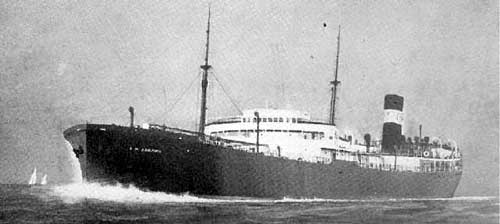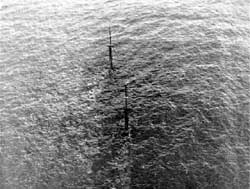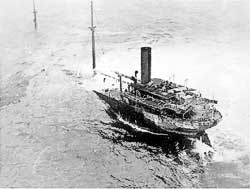(previous names: Nora [1934])
Home Port: Wilmington, DE

Esso tanker F.W. Abrams (Moore, 30)
Between the start of World War II in Europe and her ultimate demise, the Abrams made 40 trips, carrying mostly crude oil, between the Gulf of Mexico or Caribbean to various refineries on the east coast of the US.
On June 2, 1942, the Abrams left Aruba carrying over 90,000 barrels of crude oil with a destination of New York City. The tanker was traveling unarmed and alone. Although the U-boat war on the east coast had been raging for 6 months, there were still gaps in the knowledge of the ships that traveled these waters. Neither the British authorities in Aruba, nor the Abrams captain, Anthony J. Coumelis, were aware of the allied mine fields that were laid to protect the areas around Diamond Shoals and Cape Hatteras. This was to prove her undoing.
The Abrams rounded Cape Lookout on June 10 at about 12 noon and 6 hours later was approaching Ocracoke. Ships were under strict orders not to travel around Diamond Shoals except during daylight hours. With light falling, Captain Coumelis was contacted by the escort vessel CGC-484 and the Abrams was brought into anchorage for the night.
At 0400 the morning of 6/11, the Abrams left the anchorage under escort of the CGC-484. The escort vessel was to take the tanker south thru the mine field and then 30 miles east were she could proceed under her own guidance. The weather that morning was "moderate" with force 3-4 winds out of the SSE and alternating fog and driving rain. Visibility was less than a quarter mile. Soon the Abrams lost sight of her escort. Unaware of the minefield, Coumelis kept his slow speed and stayed on course.
At 0640, the lookout on the bow reported a torpedo wake, followed instantly by an explosion on the starboard side right under the anchor windlass. The lookout was injured and the ship sustained damage to the forepeak and dry locker in the bow. Coumelius ordered full astern and fire prevention measure taken. An SOS was sent out, claiming torpedo attack, giving the ships name and position. The captain tried to drop anchor and assess the damage, but damage from the explosion caused the windlass to fail. The Abrams was down 10 feet by its bow but in no danger of sinking. Crew on the deck then reported a u-boat astern of the ship. Unarmed, without an escort and the enemy upon him, the Captain ordered the Abrams full steam ahead with the idea of beaching the wounded tanker in shoal water before the u-boat could finish him off.
The Abrams was having difficulty responding to its Captain's orders. Due to the first explosion, there was only about 3 feet of freeboard left on the bow and the resulting tilt brought half of the propeller out of the water and effected the water levels in the boilers so the engines couldn't get full steam. At 0717 another explosion occurred amidships on the starboard side at #5 tank. This explosion buckled many of the plates on the starboard side inward and Abrams sunk deeper into the water. Waves were now washing over the forward main deck. The captain had not yet given up on his ship, but he ordered lifeboats lowered in case of fire. The Abrams was now drifting and the crew reported another U-boat sighting. A third explosion occurred. This one, more powerful than the previous two, occurred on the port side at #4 tank. The Abrams started sinking fast and at 0740, the Coumelis ordered abandon ship.
The entire crew (36) got into lifeboats and rowed the 10 miles to shore. They arrived 5 hours later near the Ocracoke Lifeboat Station and were later taken to Morehead City. Captain Coumelis returned to the Abrams to assess whether salvage was possible — the stern stayed afloat until 6/14 — but eventually the waves battered ship and the tanker sunk on 6/15 with only its masts above water. In 1944, the Naval Salvage team blasted and wire-dragged the wreck, knocking down the masts and tanker to a least depth of 40 feet.
What about the u-boat reports? After an investigation, it was determined that upon losing sight of its escort, the Abrams went off course and into the Hatteras minefield and denotated a friendly mine. Upon hearing the tankers SOS, the CGC-484 returned to the stricken vessel and its low profile was mistaken for a u-boat by the panicked crew. The captain, determined to beach his ship on the nearest shoal water thus saving it from the boat, unknowingly sent the Abrams into the thickest part of the Hatteras minefield, detonating mines #2 and #3. The literal and figurative fog of war and its associated stresses proved as effective as any boat.


F.W. Abrams on the bottom (Gentile, 30)
F.W. Abrams, stern above water (Gentile, 30)













